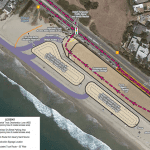
A $20-million project to bring sand to a 6,200-foot stretch of Broad Beach is entering the final stretch of a multiagency approval process that began in 2011.
The lead agency, California State Lands Commission (CSLC), has put the project out for public comment prior to being considered at their Los Angeles meeting on October 14.
The project, privately funded and proposed by the Broad Beach Geological Hazardous Abatement District (BBGHAD), includes the restoration of 46 acres of beach and sand dunes from Lechuza Point to Trancas Creek Lagoon using an estimated 600,000 cubic yards of sand hauled from three commercial quarries in Ventura County. The project would aim to address geologic hazards at Broad Beach associated with storms, flooding, beach and dune erosion, and anticipated sea-level rise.
But resident and activist Hans Laetz, who lives in the Surfside Way/Seastar Drive neighborhood closest to the staging area, fears the project could bring on months of headaches for locals. Because Broad Beach homeowners used the same staging area for the emergency rock revetment in 2010, the neighborhood got a preview of what to expect this time around.
In a letter to BBGHAD attorney Ken Ehrlich detailing his concerns about noise and traffic, Laetz asked that the project make specific plans to minimize the noise from back-up beepers that go off when a piece of heavy equipment is put in reverse. He also questioned the use of generators in an area where power is available from Edison.
Laetz pointed out that most houses in his neighborhood keep their windows open, and noise will come in from the dumpsite 14 hours a day, including traffic noise from cars and motorcycles stopping and starting at the temporary traffic light – he wants a plan to mitigate those impacts. In addition, Laetz demanded a plan that does not allow independent truck drivers and subcontractors to idle in illegal places or use the Trancas Country Market as a truck stop.
Ehrlich said, “The BBGHAD intends to respond to Han’s comments…in concert with other comments received.” He maintains the BBGHAD has been working with the city, county and Caltrans all along on the staging area at Zuma, including minimizing or eliminating the need for delivery trucks to back up.
A 500-plus page document detailing revised plans spells out the potential impacts of the project to public lands. If the document is approved, the CSLC will issue the BBGHAD a lease for 40.5 acres of state land, including 27 acres of intertidal beach and 13.5 acres of sub-tidal (underwater) beach.
Once the project begins, it’s estimated to take about eight months to complete, including 30 days to construct the dune system and another 30 days for dune restoration.
The hauling of inland quarry sand to Broad Beach is expected to take five months and an estimated 43,000 truck trips, which works out to 420 heavy truck trips per day – one inbound truck every two minutes.
Zuma Beach parking lot 12, at the far western end near Trancas Lagoon, would be used as a staging area for trucks to dump and pick up sand. The area would be closed to the public due to the operation of heavy trucks, scrapers and bulldozers. Construction staging would take up 260 spaces of the parking lot, and 42 parking spaces on the PCH shoulder would be temporarily converted into a truck lane.
Most activities (e.g., earthmoving and dune planting) on Broad Beach itself would occur between 7:00 a.m. and 6:00 p.m., but hauling and stockpiling sand in the staging area could continue until 9:00 p.m.
Two temporary driveways are planned on PCH going in and out of the Zuma parking lot. An eastbound right-turn paved lane at the Guernsey Avenue/PCH intersection would allow inbound trucks to slow down and turn without affecting through traffic. The outbound PCH driveway would have a temporary traffic signal to speed the movement of haul trucks back onto PCH.
Besides the CSLC, the BBGHAD is also awaiting additional approvals from the Coastal Commission and Army Corps of Engineers. However, Ehrlich is still hopeful that construction will begin this year.
Copies of the APTR document are available for public review at Malibu City Hall and Malibu Library, as well as online at the CSLC website. All written comments must be received by 5:00 p.m. on September 15, 2014. Sheri Pemberton at the CSLC said only eight or nine letters have been received so far, mostly from attorneys and other agencies with requests or clarifications.
